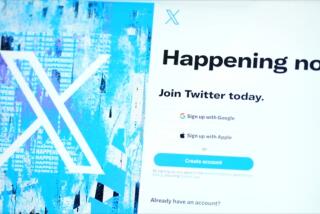Texting pioneer was a man of letters
- Share via
To understand how the wizards of Twitter settled on 140 as the magic number of characters in a single tweet, you have to go back two decades to Bonn, Germany.
One day in 1985, Friedhelm Hillebrand sat at the typewriter in his home there, tapping out random sentences and questions on a sheet of paper.
As he went along, the communications researcher counted the number of letters, numbers, punctuation marks and spaces on the page. The blurbs nearly always clocked in under 160 characters.
“This is perfectly sufficient,” he recalled thinking. “Perfectly sufficient.”
Hillebrand and a dozen others had been developing plans to standardize a technology that would allow cellphones to transmit and display text messages.
Because of the tight bandwidth constraints of the wireless networks at the time -- they were used mostly for car phones -- each message would have to be as short as possible.
Before his typewriter experiment, Hillebrand argued with a friend about whether 160 characters provided enough space to communicate most thoughts. “My friend said this was impossible for the mass market,” Hillebrand said. “I was more optimistic.”
His optimism was warranted. Americans last year started sending more texts than they made cellphone calls, according to a report from research firm Nielsen Mobile.
It’s been a boon for telecoms. Giants Verizon Wireless and AT&T; Inc. each charge 20 to 25 cents a message, or $20 a month for unlimited texts.
Just 10 years ago, however, there were none. Verizon Wireless adopted the technology in the early part of this decade as a way to deliver daily news and weather forecasts to cellphone users.
Later, mobile-to-mobile communication took footing in America, but even then, users could communicate only with people on the same carrier. “It really hindered the growth,” Verizon spokesman John Johnson said.
But adoption skyrocketed when telecoms pushed CTIA -- the Wireless Assn., an industry trade group, to set American standards for interoperability and short codes (the five-digit numbers used in text-in voting systems like those on “American Idol”), Johnson said.
Twitter, the fastest-growing online social network, which is being adopted practically en masse by politicians, celebrities and news outlets, has its very DNA in text messaging.
To avoid the need for splitting text messages into multiple parts, the creators of Twitter capped the length of a tweet at 140 characters. They reserved the extra 20 for the user’s unique address.
In 1985, of course, the thirty-something guys who invented Twitter were probably still playing with Matchbox cars.
Hillebrand’s unscientific investigations at his typewriter gave him new confidence in the ability of 160 characters to be useful while not tying up too much space on the carriers’ networks. And he was in position to push the format; he was serving as chairman of the non-voice services committee within the Global System for Mobile Communications (GSM), a group that sets standards for the majority of the global mobile market.
All cellular carriers and mobile phones must support the short message service (SMS), the group decreed in 1986.
The group included Matti Makkonen, who is sometimes credited as the “inventor of text messaging” because of an oft-translated Finnish newspaper article in 2002. Makkonen now refuses to accept that title, saying in an e-mail that the development of texting was a group effort among GSM members.
Looking for a data pipeline that would fit these micro-messages, researchers working within a subgroup of Hillebrand’s committee came up with the idea of harnessing a secondary radio channel that already existed on mobile networks.
This smaller data lane had been used only to alert a cellphone about reception strength and to supply it with bits of information regarding incoming calls. Voice communication itself had taken place via a separate signal.
“We were looking to a cheap implementation,” Hillebrand said in a phone interview from Bonn. “Most of the time, nothing happens on this control link. So, it was free capacity on the system.”
Initially, the subgroup, headed by Finn Trosby, could fit only 128 characters into that space, but that didn’t seem like nearly enough. With a little tweaking and a decision to cut down the set of possible letters, numbers and symbols that the system could represent, they found room for an additional 32.
The next step was to ensure that a cellphone could send messages to another phone, Trosby, currently a senior advisor for Telenor Mobil, said in a phone interview from Oslo, Norway. SMS was initially designed as a one-way system, a replacement for pagers.
With that completed, Hillebrand’s committee still wondered, would the 160-character maximum be enough space to prove a useful form of communication? With no market research, they based their initial assumptions on analysis of two other forms of communication: postcards and Telex, a then-prevalent telegraphy network for business professionals. They found that messages sent on each generally contained fewer than 150 characters.
Length wasn’t SMS’ only limitation. “The input was cumbersome,” Hillebrand said.
With multiple letters being assigned to each number button on the phone keypad, finding a single correct letter could take three or four taps. Typing a sentence or two was tedious.
Technology eventually made the process more palatable, including predictive typing software and QWERTY and touch-screen keyboards.
But even with those early inconveniences, text messaging took off. It’s now the preferred form of on-the-go communication for cellphone users of all ages.
“Nobody had foreseen how fast and quickly the young people would use this,” Hillebrand said. He’s still fascinated by stories of young couples breaking up via text message.
When Hillebrand, who now runs a technology patent consulting firm, tells the story of his 160-character breakthrough, he says, people assume he’s rich. But he’s not.
There are no text message royalties. He doesn’t receive a couple of pennies each time someone sends a text, as songwriters do for radio airplay.
Although “that would be nice,” Hillebrand said.
--






